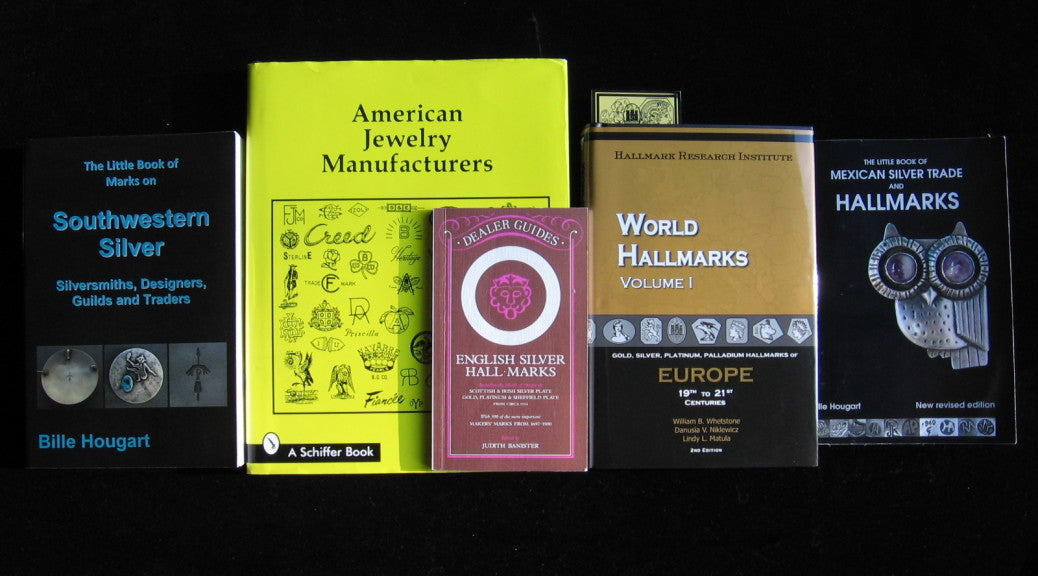One of the biggest challenges in identifying a piece of jewelry is deciphering the marks that you find on the back. You’d think that a mark would, literally, spell out what you have but many marks are symbols, initials, pictures, and sometimes fakes. There is no single book that will identify hallmarks and maker’s marks throughout the world in a comprehensive way but, depending on your needs, there are several excellent books each with its own area of specialization. If you are looking for books that provide some information about marks, but not the level of detail addressed below, see my post on Building a Library of Jewelry Books: the Basics
But first, a few definitions. There are several categories of marks found on jewelry: hallmarks, maker’s marks, and patent numbers.

Hallmarks are marks that can be thought of as an early form of consumer protection law. By requiring objects made of precious metals to be assayed (tested for precious metal content) and then marked, governments were protecting consumers, getting a source of revenue, and controlling the quality of imported goods. These marks have usually been put on a piece by a government assay office. In some countries hallmarks have been in use for centuries, in other countries there were, and are, no requirements to hallmark.
Maker’s marks are the marks put on a piece by its manufacturer to identify the manufacturer.

Sometimes a piece of jewelry will have a patent number on it. While there are no reference books that I am aware of to identify patent numbers, there area several online resources that I link to below.
Here are books that I reference regularly:
World Hallmarks, Volume I, Europe 19th to 21st Centuries by William Whetstone, Danusia Niklewicz, and Lindy Matula is an excellent resource for for deciphering the hallmarks on 19th and 20th century European jewelry. The three authors spent years researching for this book, which is well organized and easy to use despite its exhaustive detail. However, even though this book should be in every jewelry lover’s library, it’s expensive ($228 retail) and not within everybody’s means. But if you are serious about collecting or selling jewelry, this book will quickly pay for itself by helping you decipher a wide range of hallmarks.
English Silver Hallmarks edited by Judith Banister covers the UK, going as far back as 1544 in an inexpensive, pocket-sized guide. This book is easy to use and invaluable for identifying jewelry from the UK.
American Jewelry Manufacturers by Dorothy Rainwater is the classic book for identifying American maker’s marks. Covering both fine and costume jewelry, this book includes short descriptions of some companies in addition to their maker’s marks. One caveat: this book was published in the 1988 and a lot of information has been made available since then. Most of Rainwater’s research was taken from trade journals and directories so, for example, she shows Marcel Boucher as having been listed in the Jeweler’s Circular-Keystone from 1950-present (present being 1988) but, as Boucher-lovers know, the company was started in the 1930’s.
Mexican Marks

The Little Book of Mexican Silver Trade and Hallmarks by Billie Hougart is essential for identifying Mexican jewelry. I love the way this book is organized. There are over 200 pages of alphabetized photos of maker’s marks along with short descriptions of some of the makers. This is followed by chapters focusing on two and three-letter intitials; names or words; eagle numbers and their associated makers; registration numbers; a glossary; and a good index. So, depending on what information you have available on your piece, there are many ways of approaching identification.
Also by Billie Hougart, The Little Book of Marks on Southwestern Silver shares the same excellent organization as his book on Mexican silver. It has a section of maker’s marks that are symbols, organized by category (animal, plant, etc.), which is very useful when there is no name or initial to point you in the right direction.

There are also several websites that are really helpful: my favorite for identifying silver jewelry is 925-1000.
Until 1954 many US jewelry manufacturers patented their designs and a patent number may appear on the back. After 1954 US jewelry manufacturers generally copyrighted their designs (so the copyright symbol of a “C” in a circle already tells you that the piece is post-1954). There are also several good sites for researching jewelry patents online:
JewelryPatents.com is useful for researching American costume jewelry by patent number. If your piece of jewelry has a patent number on it you can enter it into their database and, if the item is in the database, find out the year it was patented. Keep in mind that some patent numbers on a piece were patents for the design clasps, settings, and other fittings which may pre-date the actual piece by decades.
The Jewelry Patent Project lists jewelry patents by category. It’s a little time consuming to use, but I’ve found things there that I’ve not found anywhere else.
Espacenet is the search engine for European patents.
Most books I mentioned are available via the Amazon links below or through J.M. Cohen Rare Books, a dealer who specializes in books about jewelry and fashion who I met at Jewelry Camp.


